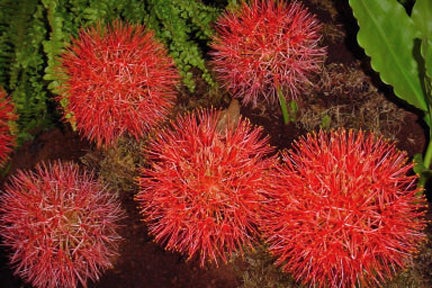
Quick facts
Common name - Blood lily, shaving brush plant, Cape tulip
Botanical name - Haemanthus and Scadoxus
Group - Houseplant
Flowering time - Summer to autumn
Planting time - Re-pot occasionally in spring or early summer
Height and spread - 20-30cm (8-1ft) by 15cm (6in)
Aspect - Bright light
Hardiness - Tender minimum 10ºC (50ºF)
Difficulty - Easy
Cultivation notes
The cultivation of Haemanthus and Scadoxus is similar and relatively straightforward. There is confusion over names of these plants as Scadoxus was originally called Haemanthus and many are still sold under this name. These plants can be easily grown by following these practical steps.
- Although any good well-drained potting medium should be satisfactory, a loam-based such as John Innes No 2 with additional peat substitute such as coir or leaf mould and grit each about 20 percent by volume is ideal
- Place in bright light but filter the light when the appear to prolong flowering (i.e. move away from the window a little)
- Water freely when in growth and apply a dilute, balanced liquid houseplant fertiliser each month during the growing season (April until September)
- Keep evergreen species moist when but, with species like H. coccineus, withhold water when the leaves begin to yellow and resume watering when the new leaves appear
- Plants can be grown in a cool conservatory or greenhouse with minimum temperature of 10ºC (50ºF)
- Re-pot as growth begins, but they flower best when pot bound. The compost in containers tends to loose its structure over time so container maintenance should be carried out annually
Pruning and training
Pruning and training is generally not required, just remove the spent flowers unless you are collecting the seed.
Propagation
As with other bulbous plants, haemanthus can be propagated from offsets as well as from seed. Haemanthus readily produce offsets that can be detached, but this discourages flowering which is always better on congested plants. The offsets can then be potted up using the same growing media as for the parent plant. Plants may take three-to-four years to flower with H. albiflos.
- The fleshy seeds should be sown soon after ripening as they are only viable for a short period
- Sow into a deep filled with well-drained, sandy
- Press seeds lightly into the surface of the compost so the top of the seed is showing
- Maintain at 16-18ºC (61-64ºF)
- Water well initially and then only when the leaves appear. Take care not to over water and make the soil soggy
- Young plants can be left in the seed trays for several years before potting up
- With H. coccineus, stop watering when the leaves begin to yellow, and only resume once the leaves reappear
Cultivar Selection
Haemanthus are mostly , to the semi-arid regions of South Africa. Mature plants have one, two, four or rarely six leathery, fleshy strap-like, leaves, upright or pressed flat on the ground. The flowers heads consist of tiny flowers clustered in compact umbel-like heads surrounded by coloured bracts and borne on fleshy stems. The flowers produce nectar and have prominent stamens, but only a faint scent. The berry-like fruit vary in colour from white, orange, pink to red and are aromatic. Haemanthus bulbs were some of the first botanical specimens collected from the Cape and H. coccineus (Cape tulip) was cultivated in the Netherlands in the 17th century.
Haemanthus albiflos (shaving brush plant, white paint brush): This widely-grown evergreen bulb has pairs of broad, usually hairy-edged, strap-like leaves. White brush-like flower heads are borne from autumn to winter, and are 3-7.5cm (1¼-3in) across, consisting of up to 50 tiny flowers with protruding stamens, followed by fleshy white to red fruit.
H. pauculifolius: Resembles H. albiflos, but bears only two, narrow hairy leaves per bulb. The small white flowers are produced on a stout stem and followed by red berries under favourable conditions.
H. coccineus (Cape tulip): Deciduous bulb with two or occasionally three strap-like leaves produced after flowering. The flower heads appear from summer to autumn and consist of up to 100 tiny red flowers with prominent yellow stamens surrounded by large scarlet bracts. Flower heads are 5-10cm (2-4in) across and are followed by fleshy, white to pink fruit.
Scadoxus are native to tropical woodland in Africa and the Arabian Peninsula and are closely related to Haemanthus. They have similar flower heads with prominent stamens but are distinguished by their spiral leaf arrangement and rhizomatous bulb.
Scadoxus multiflorus(syn. Haemanthus multiflorus) (blood lily): Evergreen with up to nine leaves with a prominent midribs and wavy margins, produced on a pseudostem that is white with purple spots. The pinkish, red flower head consists of 200 flowers packed into a spherical umbel, up to 25cm (10in) in diameter, with prominent stamens.
Links
RHS Plant SelectorRHS Plant Finder
RHS Trials, AGMs

Problems
Haemanthus are trouble free provided they are given good light, a well-drained soil and are watered sparingly. Plants will be damaged by cold and should be moved if the temperature drops below 10ºC (50ºF) – they may die if frosted.




